
Irish Tea
also known as Irish breakfast tea, English breakfast tea, Assam black tea
What is Irish Tea?
Irish tea is a hot beverage made with a mixture of black teas, typically Assam and Ceylon, although it may only include Assam tea leaves.
- This tea is commonly consumed with a lot of milk.
- This drink is very popular with the average Irish person drinking anywhere between four to six cups of it every day.
The Assam tea market generated a revenue of $287.3 million in 2020. This tea market is estimated to grow by 2.2% every year.
The top four tea brands, according to Teaocity, are:
- Golden Moon
- Stash Tea Super
- Harney & Sons
- Twinings of London
Origin of Irish tea
In the early 18th century, tea entered Ireland from England. It was most common among rich people, as most people could not afford the beverage since it was expensive to import tea. Gradually, tea became more affordable; however, the tea leaves were of poor quality and had a weak flavor. Therefore, traditional Assam tea included a lot of milk and cream to make it more flavorful.
Eventually, every Irish home had a teapot and tea parties became common among the populace of the country. During World War II, it was hard for Irish citizens to import tea. The British government had cut down the volume of tea that Irish merchants could purchase. This decision made the Irish go straight to India for tea. After World War II, the Irish began to import Assam tea from Kenya.
Function
This hot beverage is commonly consumed as a stand-alone drink. However, people do add Assam tea to alcoholic drinks. It can be mixed with lemon juice, whiskey, and bitters to make a cocktail.
Nutrition
In a serving size of 100g of this breakfast tea, there are:

Nonetheless, there are some health benefits attributed to this tea:
- It is great for individuals who want to lose weight.
- This tea has cancer-fighting properties.
- It can help to relieve tension.
- The caffeine present in it can improve your daily performance and activities.
This breakfast tea is generally safe for individuals to drink. Although if you consume it in excess, you could experience some side effects associated with the overconsumption of caffeine. Some of those side effects include restlessness, nervousness, and headaches.
Commercial production
Assam tea is the primary type of tea used in making this. The first stage in its commercial production involves spreading the tea leaves on a Hessian cloth placed over wire-mesh racks to reduce their moisture content. After this, machines crush, tear, and curl the leaves, then the tea leaves are moved to trays to undergo fermentation and oxidation. The next step is to spread the leaves on trays, where drying machines remove any remaining moisture. Finally, the Assam tea leaves are packaged for sale.
Application
Making this breakfast tea is simple with the following steps:
- If using a teapot, pour a little boiling water into the teapot to warm it. Then, discard the water.
- Next, add one spoon of Assam tea leaves per person into the teapot.
- Then, pour the boiling water into the teapot filled with leaves.
- After that, allow the mixture to steep for 3 to 4 minutes.
- Finally, strain out the tea leaves from the drink and serve with milk.
The best place to store loose Assam tea leaves is in an opaque, airtight container. Oxygen, light, and heat can damage the flavor of the tea. So, be sure to keep the leaves away from humid and warm conditions. If you store the leaves properly, they can last for 18 to 24 months.
Irish tea recipes
This classic breakfast tea can be enjoyed in many ways. Here are some popular recipes:
FDA regulation
The Food & Drug Administration details the recommended amount of tea consumed per eating occasion for individuals. This reference amount serves as a basis for determining the serving size of tea products. Also, tea brands need to comply with labeling guidelines set by the FDA. Information required to be on the tea label includes ingredients list, name of the manufacturer, identity statement, contents declaration, and nutritional information. The FDA also regulates milk, which it defines as the lacteal secretion from the milking of healthy cows.
References
“Tea – Ireland: Statista Market Forecast.” Statista.com, Statista, www.statista.com/outlook/30020000/140/tea/ireland.
Frey, Malia. “Assam Tea Benefits and Side Effects.” 25 June 2019, verywellfit.com, verywellfit blog, www.verywellfit.com/assam-tea-benefits-and-side-effects-4163613.
Post author Scientific review: Dr. Heben’s Team. “10 Health Benefits of Irish Breakfast Tea # Relaxing.” drHealthBenefits.com, drhealthbenefits blog, 18 Apr. 2018, drhealthbenefits.com/food-bevarages/beverages/tea/health-benefits-of-irish-breakfast-tea.
Brienza, Laura. “Drink Me. I’m Irish: Irish Tea Cocktails For St. Patrick’s Day.” blog.theteakitchen.com, Tea, Tea Accessories & Recipes – The Tea Kitchen, blog.theteakitchen.com, 8 Mar. 2017, blog.theteakitchen.com/tea-recipes/st-patricks-day-irish-tea-cocktails/.
